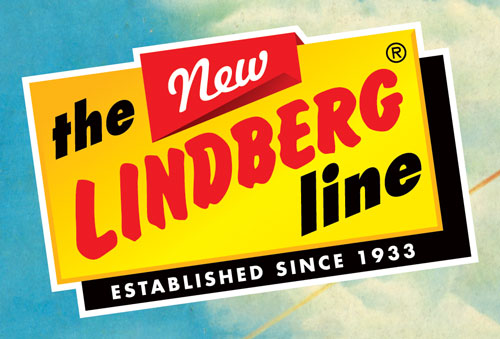

Posts Tagged ‘history’
Lindberg Model Kits: Mini Lindy’s: An Illustrated History 1980s & 90s
This is the 3rd and final part of an illustrated history of the Lindberg’s Mini Lindy line based on found images, catalogs and info from some modeling sites.
In 1980 4 more garage kits were made under the Truckin’ Big series.

All new tractor trailer kits were made in 1982. A mix of 2 semi-trucks (GMC Astro & Ford CL-9000) and 4 trailer variations made up the 8 releases. The first 4 in these series were reissued in slightly different packaging at some point before 1987.

In 1984 the addition of a tanker trailer lend itself to 4 more truck kits.

In 1990 the Miniature Mint Collection 2-packs were introduced. The 1990 catalog showed 6 kits, No. 72301-06, showing 8 previous cars and 4 new ones. Ultimately only 4 of the 6 two-packs were released. In 72303, the 1932 Ford was replaced with the newly-tooled 1990 Corvette ZR-1. In 72304, the MG-TD was replaced with the newly-tooled Lamborghini Countach. From what I can tell the 1990 Camaro Z28 and the Ferrari Testorossa were never tooled.


The final Mini Lindy release was the Super 8: Street Machines in 1991 feature 8 cars: 1964 Corvette, Jaguar XKE, 1970 Corvette, 1967 Mustang, Corvette ZR-1, Chevy Pickup, Lamborghini and 1968 Camaro.

Some of the dates and images were found on these fantastic sites….
Commenters let us know……Should we bring these back? What kits do the modelers want to see?
Lindberg Model Kits: Mini Lindy’s: An Illustrated History 1970s
This is part 2 of an illustrated history of the Lindberg’s Mini Lindy line based on found images, catalogs and info from some modeling sites.
In 1970 the existing kits from the 60s were rereleased with new packaging and item numbers; 8 under the name 1971 Hot Shot and 8 under the name Mod Rod which included psychedelic flower decals. Other Mod Rod versions of previous cars were made available though a mail-in promotion; they came in plain boxes but included Mod Rod decals and instructions. These included the Porsche Carrera, the “1971” Corvette, the Ford Mustang, the Jaguar XKE and probably more.

In 1971 8 of the original trucks were rereleased under the name Big Wheels. That same year seven new cars were released under the name 1972 Super Sport. The ’68 corvette was included to round off the 8. New cars included the Cadillac Eldorado, Lincoln Continental Mark III, Chevrolet Vega, Buick Riviera, Gremlin, Monte Carlo and Pontiac Grand Prix (in catalog as Grand Ville). The Super Stock series are some of the more difficult to find Mini Lindy kits. One interesting thing to note is that the Pickup Camper was a Ford now it is a Chevy. The box art is the same as the 1960s but has been altered slightly. I believed the pickup was altered for a dealer promotion, because the Camper can be found in pink & orange striped Chevy promo boxes. The chrome grilles look different but the bodies are similar enough that the tool may have just been altered. It still has the number 22 on the underside of the body.


In 1972 some of the trucks were released in 2-packs.

In 1975 10 trucks, vans and bus were released under the Hi Rollers series. The back of the packaging showed all the releases except for the 2 buses.

In 1976 8 cars were rereleased in the Speedy Wheels series.

In 1977 the Van Go series added a new twist to 8 previous cars with bold graphics and glitter in the injection plastic.

In 1979 the Car and Garage Kit series include a plastic garage with windows and an opening garage door. The Cadillac Eldorado and Lincoln Continental Mark III returned for the first and last time.


Look for my next post for part 3 – the 80s & 90s.
Some of the dates and images were found on these fantastic sites….
Lindberg Model Kits: Mini Lindy’s: An Illustrated History 1960s
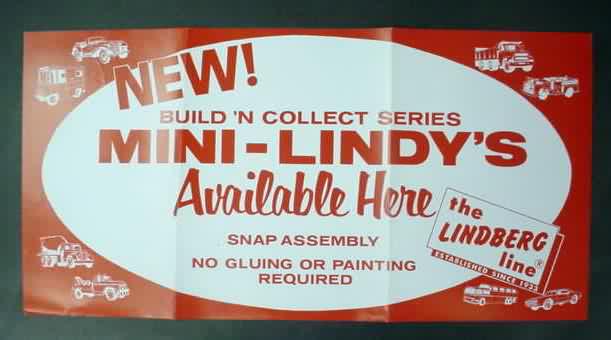
This is an illustrated history of the Lindberg’s Mini Lindy line based on found images, catalogs and info from some modeling sites.
Part 1 – 1960s
The first 24 Mini Lindy cars were produced between 1967 and 1968 with the first 16 appearing in the 1968 catalog. The vehicles were HO scale plastic kits that included clear parts, chrome parts, metal axles, rubber tires and a decal sheet. They came in black boxes with the model illustration appearing in a white oval. On the reverse side appeared a rear view of the vehicle. Three variations on the packaging appeared: a basic box, box with a flap for hanging and a cellophane version that was just the basic box with the back illo cut out. On the back of the flapped version was a list of kits numbered 1 to 32, though at that time only 24 had produced. The list also changed a bit on kits 17-24.

In 1969 7 “red box” kits were released; kits were numbered 25 to 31. An oddity… #32 Ryder Moving Truck appeared in a black box. Not sure of the release date but given that the kits were released in groups of 8 generally I would think this would have been released with #25-31, but I don’t know. The list on the flaps changed again to reflect the final 32 kits. Seems as though #25 Pontiac Firebird, #28 Jaguar D, #29 Bobtail T, #31 Station Wagon Vista-Cruiser, #32 Stake Truck, and #32 Oil Truck were unproduced. The 1969-70 catalog still only showed the first 16 kits.


Look for my next post for part 2…….
Some of the dates and images were found on these fantastic sites….
1:32 Kitbash: 1930 Ford Model A Roadster Pickup – Part 3

This is the final part of my 1930 Ford Model A Roaster Pickup kitbash using the Lindberg 1:32 Customizable Show Rod 2-pack and Lindberg 1:32 1930 Ford Model A Pickup.
Parts are painted, now it is time for assembly.

As mentioned in part 2, I assembled the motor using the “Rear Mill Bucket” instructions. As shown above.

Next I assembled the frame (A1), body (A3+A4+A5+A6), dash (A17), steering wheel (A19), windshield (a9), glass (A25), bed (A7a), grille (A2), tail gate (A8), and interior of the cab (A10) as shown in the Model A Pickup instructions. I replaced the gear shift with the chromed one from the Super Roadster (part R10).


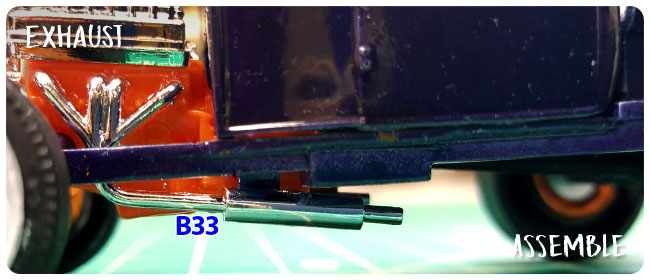
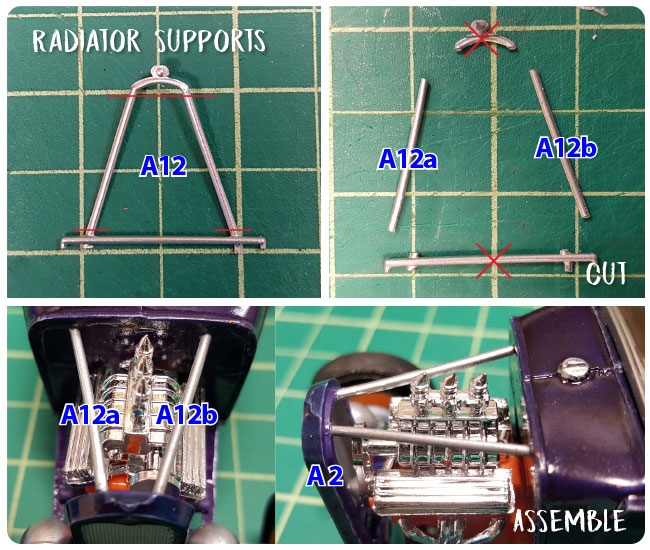




1:32 Kitbash: 1930 Ford Model A Roadster Pickup – Part 2
Goto PART 1

This is part 2 of my 1930 Ford Model A Roaster Pickup kitbash using the Lindberg 1:32 Customizable Show Rod 2-pack and Lindberg 1:32 1930 Ford Model A Pickup.
Above are the parts from each kit that were used. Note that I will reference 1930 Ford Model A Pickup kit part with an “A” in front of the part number, “B” for the Lucky Bucket and “R” for the Super Roadster.

First I removed the fenders from the frame (A1). Cutting along the the red lines as shown above. I discarded the fenders (i.e. set them aside for future projects).

Next I separated the hood from the cowl halves (A5,A6), cutting along the red line. The hood halves were not used on this build, so discard. The cowl halves (A5,A6) and the body sides (A3,A4) were then glued together.


I wanted to shorten the pickup bed (A7). The excess is be used in next step, so you would need to remove at least 7mm, I went with 11mm. I will refer to the halves now as parts A7a and A7b. I also trimmed 11mm off the bed on frame (A1). The excess from A1 is discarded.

The body (A3+A4+A5+A6) is missing a firewall so I used part A7b to create it. I cut it into the pieces shown above and then cut 3 pieces down to fit in the cowl (A5+A6). The pieces were about 7mm wide and A7c was cut to fit the curve of the cowl. Parts A7c, A7d and A7e were glued to the body.
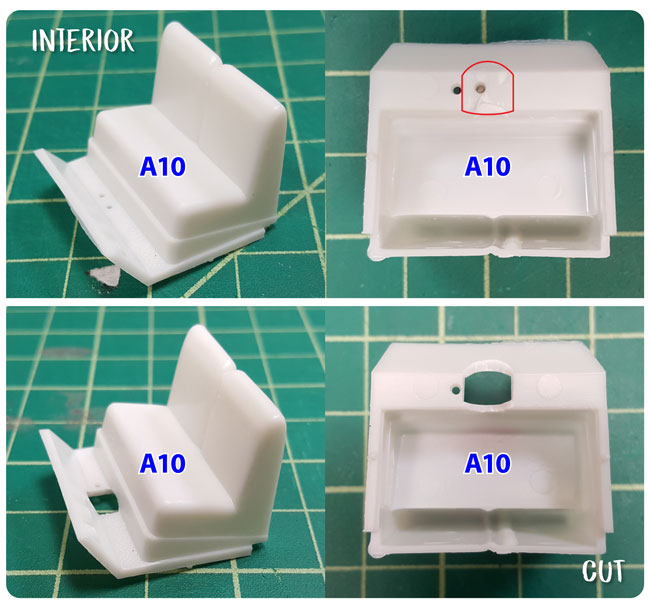
Next I cut a “hole” in interior’s floor (A10) to make room for the drive shaft (R30) from the Super Roadster.

I cut the hood ornament from the grille (A2). I didn’t like it.
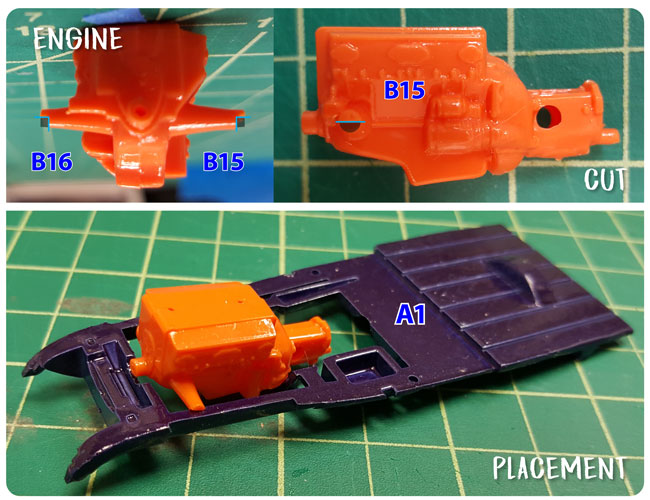
I used the motor halves (B16,B15) from the Lucky Bucket. I cut a half circle from the end of the support rods that enable the engine to sit perfectly in place on the frame (A1) with very little modification. Note I had to cut a half circle notch off the frame at the front of the engine to leave room for the belt (B43). For the motor assembly I used the “Rear Mill Bucket” version, option B on the instructions for the Lucky Bucket, but with different exhaust. I will show this in my next post.

Next I painted the parts as shown above. My paint scheme was inspired by the vintage Lindberg Freaky Ford kit. (as mentioned in Part 1) I painted the frame (A1), body (A3+A4+A5+A6), dash (A17), bed (A7a), grille (A2), and tail gate (A8) a metallic grape purple, first hitting them with a dull medium blue then the purple to give the color a little more depth. I painted the wood planks on the bed to look like wood and the grille and gauges chrome. The interior of the cab and the seats were painted tan. The front radius rod (A12), headlight assembly (A18), bumper (A20), windshield frame (A9) and 4 wheel hubs (R55) were painted chrome. The small front wheels (R27,R28), rear wheels (R32,R33) and drive shaft were painted black. The rims on the wheel were painted orange and whitewalls were added.
Look for my next post for final modifications and assembly.
1:32 Kitbash: 1930 Ford Model A Roadster Pickup – Part 1
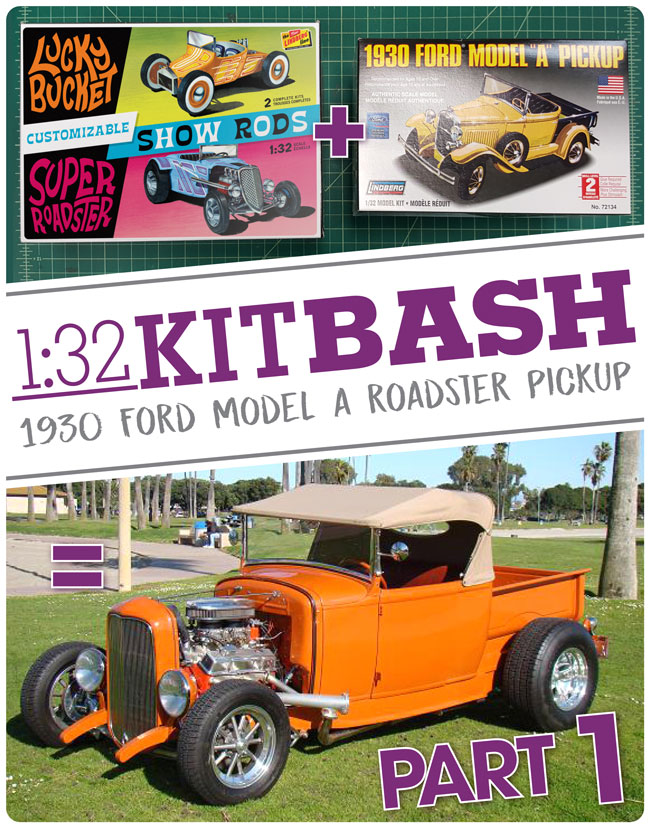
As mentioned in a previous post the Lindberg 1:32 Customizable Show Rod 2-pack will be out soon and one of the cool features is the many parts that can be used to customize the kits – 125 parts to be exact! The kit includes instructions to build the 2 cars in three different ways but with the parts being interchangeable you could customize many more.
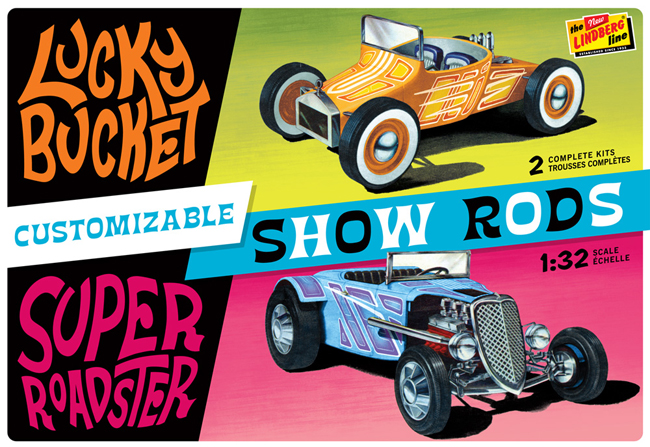

Often not seen in 1:32 car kits are detailed engines and the Show Rod kit includes 2. I realized the Lindberg line has many older 1:32 releases that could be kitbashed with the Show Rods. My goal is to use the parts in the new release to customize the Lindberg 1:32 1930 Ford Model A Pickup, item number 72134. For the paint inspiration I will use the 1975 boxart of Lindberg 1:24 Freaky Ford. Check out my next post to see my progress.

Save
Round 2 Model kits: Building a Reputation
First a quick apology… Technical difficulties prevented me from posting this yesterday, which would have made it a bit more pertinent.
Nostalgia… We are fully aware that this factor may be the most significant thing that provides the success we have with our AMT, MPC, Polar Lights and Lindberg models. Many of us remember building kits as kids. Some saved their builds and have done their best to hold onto them to this very day, but I’m betting the greatest majority suffered similar fates trying to withstand a black cat or twenty. Even still the surviving “fan” in each of us has drawn us back over time and Round 2’s faithful (and usually improved) reissues of vintage plastic kits supply the kits we remember so well the in WAY that we remember them.
I’ve made no secret of my love for comic books and just as most modelers do, I have my own list of “Grail” comics, but I was lucky enough recently to obtain the one item at the top of my list. It is something I thought I would have to wait a long time to find and had limited hopes of having the cash on hand to purchase when found. But the stars aligned for me this time so I could experience the jubilation of landing the “thing” of my dreams. Some middle-aged men need a hot rod. Others are equally as happy to obtain a 1/350 scale TOS Enterprise or 22” Eagle Transporter. For me, it was a comic book spinner rack just like we remember from our childhood. Some of my earliest memories are of going to our local supermarket (the building still stands and was only ever as big as a 7-11 we have today), going to the cereal aisle to pick out the one box that seemed to offer the best balance of fruity/chocolaty/sugary goodness with the best prize soon to be dug out of the bottom. This was immediately followed by a jaunt to stand in front of the spinner rack while my mother shopped. It was for all intents and purposes my baby-sitter for the rest of the trip to the market. Mom had no fear I would wander anywhere else. And in those days, it wasn’t child endangerment if any other adult was around to ensure I wasn’t kidnapped. Oh, what a difference 40-odd years makes… But now, I have one of my own to fill with reading copies and books I clearly recall buying directly “off the rack.”
I mention this tale as a means to touch on the fact that I know what it is like to finally find a fan-grail and how I appreciate the opportunity to create products that fill that level of demand for our consumers. Though I can’t “regret” it, because it is out of my control, I just wish we were in a position to do more and more quickly. That said, I want to assure you we have the ball rolling on a few big things… Grail-level things. Things sci-fi modelers have been asking for for a long time and I’ve been saying “maybe someday” kinds of things.
As I’ve been filling my spinner rack I’ve taken notice of some of the model kit ads that showcased our brands. Heck, half the fun of looking at old comics is looking at those goofy old ads. Here are a few I’ve found…
Lastly, I’d like to take a moment to officially commemorate the 50th anniversary of STAR TREK. We can all appreciate the future it imagined for us and even the gadgets we already enjoy 250 years ahead of time. With hand held communicators & computers and now replicators, transporters should be right around the corner. The characters are truly iconic and will always be… but because of my relationship with the model kits we’ve developed, I think I like the U.S.S. Enterprise the best. She was a character, and most of the episodes I liked the best featured her as a main component. So, here is to STAR TREK, Captain Kirk & crew, and the U.S.S. Enterprise. Live long and prosper…
Lindberg Model kits: 1:32 Customizable Show Rods! A Brief History
We have a 2-pack of 1:32 Customizable Show Rods that will be coming out soon under the Lindberg model kit line. The pack includes a 1930s roadster and a 1920s rear-engine bucket that include a slew of interchangeable parts, so you can customize to your heart’s content. These fun little kits were originally released separately in 1965 as part of a series of 4 kits. The Roadster was released as the Super Custom Deuce, a 3-in-1 kit including Street Roadster and B Altered variations, and as the Blown Buggie. The Bucket was released as the Kookie Contender, a 3-in-1 including Scoopster and Rear Mill Bucket variations, and as the Tuned Tinker. Over the next 11 years Lindberg put out 6 more versions of each kit. Notable releases include the hard to find Glo-Karts in ’72, Rainbow Rods in ’73, and the blue jean themed Jumpin’ Jeans in ’75. Because who doesn’t want their hot rod covered in denim?
Now for the FIRST TIME EVER the new release will include chrome parts! The rest of the parts come injected in bright, bold colors. The kits will each include 2-3 options for grilles, headers, carburetors, front suspension, and hubcaps. Additional parts include a soft top, scoops, blowers, tires, front & rear fenders, rear bumper, tail lights, and roll bars. The large decal sheet is all new featuring funky show rod patterns and multiple options for customizing. Given all the options for these kits I am excited to see what modellers will do with them.
Roadster…

Bucket…

1970s…

Lindberg Model kits: New Attitude, New Logo!
Since acquiring Lindberg, one of our main goals at Round 2 has been to do right by the rich history of the brand and the people that grew up building Lindberg kits. We are celebrating that history by bringing back many of the vintage illustrations and feel of the old packaging while giving Lindberg a new look, improved tooling, new instruction sheets, and more versatile, historically accurate decals. We want to revitalize the brand and put out products that we can be proud of and putting right what once went wrong! With this new attitude comes a new logo.
In 2013 we brought back the vintage yellow rectangle logo that everyone knows and remembers. We wanted the new logo to be reminiscent of that logo but have a fresh feel, representing a tribute to Lindberg’s past while moving into the future.
And a trip down memory lane…..










